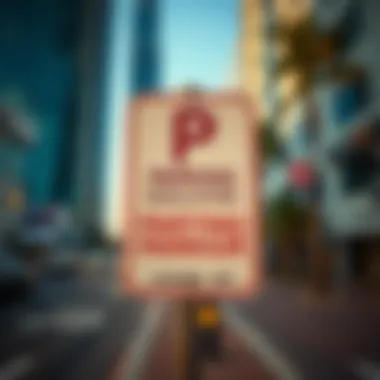Public Parking in Dubai: A Comprehensive Overview


Intro
Navigating the parking landscape in Dubai can feel a bit like trying to find your way through a maze. With a fast-paced urban environment and a growing number of vehicles on the road, both residents and visitors need to be well-informed about the diverse public parking options available. As this city continues to evolve, understanding the nuances of public parking becomes crucial not just for convenience, but also for implementing smart urban strategies.
This guide dives into the various aspects of public parking in Dubai, from existing regulations to future innovations in parking solutions. Exploring these elements will equip you with the knowledge to make sound decisions whether you're a resident looking for daily parking solutions or a visitor trying to navigate the bustling streets.
In every nook and cranny of this city, there's a story to tell about how parking is tailored to enhance urban living. You'll find a range of topics that paint a clear picture of the public parking scene, so sit tight.
> "Understanding the parking policies is just as vital as knowing the best routes to take in this sprawling metropolis."
Market Trends
As we delve into the current market trends regarding public parking in Dubai, it’s essential to recognize the implications these trends have on residents, investors, and urban planners. Understanding what's driving parking trends can pave the way for smarter investment decisions and more efficient parking experiences.
Current Property Prices
The cost associated with parking in urban areas has been on a rollercoaster ride. In key areas, particularly in Downtown Dubai and the Marina, prices have spiked due to high demand. Expect to pay anywhere from AED 5 to AED 20 per hour, depending on the location and time of day. Additionally, areas with shopping centers and popular landmarks often witness higher rates during peak hours.
Future Market Predictions
Looking forward, the public parking market in Dubai is expected to undergo significant transformations. Here are a few noteworthy trends:
- Rise of Smart Parking Solutions: The integration of technology will lead to real-time updates on parking space availability, reducing search times considerably.
- Increased Regulations: As urban density increases, regulations around parking spaces may tighten, pushing for more efficient use of available space.
- Sustainable Practices: Future developments might focus on creating eco-friendly parking solutions, possibly incorporating electric vehicle charging stations and bike parking areas.
By keeping an eye on these trends, stakeholders can better position themselves to take advantage of changing dynamics in the public parking sector.
Overview of Public Parking in Dubai
Understanding public parking in Dubai is crucial for anyone navigating the urban landscape, be it residents, visitors, or business interests. With the city's ever-growing population and influx of tourists, efficient parking solutions play a key role in easing traffic congestion and keeping the city moving. From bustling commercial districts to relaxing residential neighborhoods, the parking infrastructure reflects the growing demand for accessible parking options that cater to various needs.
Historical Context
Dubai's parking scenario has evolved significantly as the city transformed from a quiet seaside town to a bustling metropolis. Early on, informal parking arrangements sufficed, but as development boomed, a structured approach became paramount. Recognizing this, the city implemented regulations to streamline parking accessibility and address the burgeoning vehicle population.
In the early 2000s, a noticeable shift took place. Multi-storey parking facilities began popping up alongside the development of major highways and public spaces, integrating parking within urban planning. The introduction of paid parking zones in high-demand areas marked a pivotal step towards managing public resources more effectively.
Current Parking Infrastructure
Key Locations
Within Dubai, certain locations stand out as major hubs for public parking. Areas such as the Dubai Marina, Downtown Dubai, and Deira feature prominently. These key locations not only host a large volume of vehicles but also cater to various commercial activities.
The Dubai Marina, with its stunning waterfront and multitude of shops, provides several multi-story parking structures, offering easy access to its vibrant lifestyle and keeping visitors satisfied. On another front, Downtown Dubai is populated by high-rise buildings and leisure venues that demand a robust parking setup. With several underground parking options available, this area accommodates both residents and tourists seeking entertainment and dining.
However, the surge in vehicles often leads to full parking lots during peak hours, prompting the need for efficient management. While these areas are convenient, they can also be quite crowded, reflecting the challenges of balancing urban development with parking availability.
Types of Facilities
The public parking landscape in Dubai encompasses a range of facilities, from surface lots to modern multi-storey parking, each playing a specific role in the city’s transportation network. Surface parking can be found in neighborhoods and commercial districts, providing quick access for short-term stays. This type of facility typically features straightforward payment options, making it popular with day-to-day visitors.
On the other hand, multi-storey parking garages have become a hallmark of Dubai's modern infrastructure. These facilities offer considerable capacity and are often strategically located near major attractions. Examples include the Burj Khalifa parking lot, which caters to visitors intending to access the world’s tallest building. While they might require a bit more navigation, these structures resolve the issue of limited ground space and ensure a more organized approach to parking.
Balancing convenience with efficiency, the parking facilities of Dubai reflect the city’s ambition to remain a frontrunner in urban planning. As the demand for parking continues to grow, innovations are gradually being integrated, hinting at an exciting future for public parking solutions.
Types of Public Parking


Public parking in Dubai can be quite varied, ranging from basic on-street options to more complex off-street facilities. Each category has its own benefits, and understanding these can be crucial for both residents and visitors. Public parking often serves as the backbone of urban mobility, facilitating not just individual transport needs, but also influencing the overall traffic flow and urban development in a growing metropolis like Dubai.
On-Street Parking
Pricing Structure
The pricing structure for on-street parking in Dubai is designed to be straightforward yet flexible. Charges may vary depending on the location, time, and duration of parking. Generally, popular areas such as downtown or near tourist attractions command a higher fee compared to suburban regions. The key characteristic of this pricing model is its hourly rate system, which can be adjusted based on demand. This helps in managing parking availability and incentivizing turnover.
One unique feature is the use of payment apps that allow you to pay for parking directly from your mobile device. This option provides convenience but may come with service fees. The advantage is that you don't need to fumble for coins or worry about running back to add more time. However, relying on technology means potential pitfalls if the app malfunctions or if connectivity issues arise.
Regulatory Compliance
Regulatory compliance governs how on-street parking operates within Dubai. This framework includes rules about allowable parking times, designated areas, and even vehicle types allowed in specific spaces. The key characteristic here is the clear signage that marks out parking regulations. These signs help avoid confusion and promote adherence to the rules.
Failure to comply can result in fines, which brings us to the unique feature of penalties that differ significantly from one area to another. A possible disadvantage is that some areas may implement stricter rules, which can catch new users off guard if they don't pay close attention to the guidelines. Emphasis on compliance serves to maintain order but can also contribute to user frustration when misunderstandings occur.
Off-Street Parking
Public Parking Lots
Public parking lots are a staple in Dubai's parking ecosystem. These lots provide an excellent solution for drivers needing a secure place to park their vehicles, especially near malls and business districts. Their key feature is often a dedicated management system that ensures safety and efficiency.
The advantages of utilizing these lots include ample space compared to on-street options and extended hours of accessibility. However, one could argue the disadvantage is the potential cost, especially in premium locations where parking rates can quickly add up.
Multi-storey Parking Garages
Multi-storey parking garages are on the rise in Dubai, especially as urban density increases. They allow for a significant number of vehicles to be parked in a compact area. Its key characteristic is vertical space utilization, which maximizes available land in high-demand areas.
One strong advantage is that these garages typically have better security measures compared to surface lots, which could appeal to those concerned about car theft or damage. On the flip side, disadvantages might include the potentially confusing layouts and the time it may take to find a spot during peak hours. Not to mention, driving into a tight parking structure can be daunting for some.
Smart Parking Solutions
Technology Integration
In recent years, Dubai has started integrating technology into public parking systems with remarkable enthusiasm. This integration helps streamline the parking experience for users. A key characteristic of technology integration is the utilization of sensors to monitor parking space availability in real-time. This allows drivers to easily locate available spots, saving time and reducing frustration.
The unique feature of this technology is its communication capabilities with mobile applications, making it easier for users to find parking without endless searching. However, there’s a potential disadvantage to consider: reliance on technology means that any failures could lead to confusion or even misinformation.
Benefits and Challenges
The benefits of implementing smart parking solutions are significant. They enhance efficiency, reduce congestion, and provide a better user experience overall. The key challenge, however, is the initial cost and required maintenance of such systems. Many stakeholders wonder if the investment is really worth it over the long term.
For example, in some cases, the rollout of smart technologies has hit bumps, often leading to questions about system reliability and the necessity for constant updates. The balance between advantages and challenges is essential for stakeholders to monitor as the city moves toward a more technologically-integrated future.
"While navigating public parking in Dubai has its challenges, the city's commitment to innovation and improvement remains steadfast."
In summary, understanding the types of public parking available in Dubai—both on-street and off-street—provides valuable insights into the urban fabric of the city. It highlights the importance of regulatory compliance, available technologies, and the overall impact on local mobility.
For further reading on public parking systems and initiatives, check out reputable sources like Dubai Government or Wikipedia.
Parking Regulations and Policies
Understanding parking regulations and policies in Dubai is essential, as they ensure the proper management of the city's parking infrastructure. These regulations not only regulate space allocation but also influence traffic flow, safety, and environmental sustainability. Stakeholders, from investors to expatriates, need to grasp these regulations to navigate the urban landscape more effectively.
Regulatory Framework


Licensing Requirements
When it comes to licensing requirements, they serve as the backbone of Dubai's parking regulations. Every operator of a commercial parking facility must secure the necessary licenses from local authorities. This process ensures that all parking venues uphold safety standards and operate efficiently. It's a beneficial structure as it maintains a level of quality across facilities, thereby safeguarding public interests.
One key characteristic is that applications often necessitate comprehensive documentation, both providing transparency and establishing accountability. For instance, this includes proof of financial capability and adherence to safety protocols. The licensing system aims to streamline operations while minimizing chaos in a city known for its rapid urbanization. However, the stringent nature of these requirements may also pose a challenge for small operators wondering how to meet such standards amidst competitive pressures.
"A licensed parking facility uplifts the neighborhood while ensuring peace of mind for its users."
Fines for Non-compliance
Following the licensing requirements, the fines for non-compliance present another critical aspect of the regulatory framework. These penalties are designed to deter improper behavior and ensure adherence to established parking norms. It's a necessary evil that ensures the system runs as smooth as a well-oiled machine. The fines also serve as a crucial revenue source for Dubai's urban management initiatives.
The most compelling aspect of this policy lies in its dual purpose: safeguarding public amenities while educating the populace about correct parking practices. An interesting feature is that fines tend to vary depending on the severity of the infraction; habitual offenders may find themselves facing heftier penalties. On the downside, excessive fines could foster resentment among drivers who might feel overwhelmed by rising parking costs, especially during peak times.
Parking Zones
Residential vs. Commercial Areas
Diving deeper into parking zones, the distinction between residential and commercial areas plays a significant role in how parking is structured in Dubai. In commercial areas, you’ll often find more facilities designed to accommodate high volumes, as these zones are frequented by shoppers and business clientele. Conversely, residential zones generally offer more limited space, focusing on serving local residents.
This unique division emphasizes the city's balanced approach to meet various demands, ensuring that both residents and visitors can find suitable parking. By regulating these zones differently, the city can better manage traffic patterns and enhance overall accessibility. However, conflicting demands can arise, and overzealous enforcement in residential areas could lead to discontent among residents who may find it difficult to park near their homes.
Priority Parking Initiatives
Lastly, priority parking initiatives are crucial amidst concerns for urban mobility. These initiatives aim to allocate prime parking spaces for specific groups—like pregnant women or residents with disabilities. The significance cannot be understated as it embodies inclusivity in urban planning, enhancing quality of life in the hustle and bustle of city life.
Notably, these initiatives often come with distinct benefits, such as reduced congestion in high-demand areas. They can foster goodwill among community members feeling that their needs are recognized. Yet, there's a unique challenge: balancing these priorities with the demand for general parking can create tensions, especially in crowded areas where everyone feels entitled to the "best spot."
All in all, parking regulations and policies in Dubai play an essential role in shaping the city's parking landscape. By comprehensively understanding these elements, stakeholders can better navigate the complexities of parking, tailor their investments, and experience the city with ease.
Impact of Public Parking on Urban Mobility
Public parking plays a vital role in shaping urban mobility in Dubai, influencing how residents and visitors navigate the bustling city. The system of public parking affects not only the ease of access to various destinations but also the broader implications for traffic flow and environmental sustainability. With an ever-growing population and a surge in visitors, understanding these impacts is essential for all stakeholders involved.
Traffic Management
Congestion Mitigation
Congestion mitigation stands at the forefront of traffic management strategies in urban areas like Dubai. Finding ways to smooth out the flow of vehicles helps ease the burden on roadways—this is particularly critical during peak hours when everyone is trying to get somewhere fast. Efficient parking systems reduce the time vehicles spend roaming for available spots, which directly decreases congestion on the streets. The unique characteristic of effective congestion mitigation is its capacity to manage inflow and outflow in high-traffic areas.
While it certainly has advantages, like improving air quality by cutting down idle times, there are some hurdles, too. For example, if parking is poorly managed, drivers could end up circling multiple times, actually worsening overall traffic. This all means that a well-structured parking system is one of the most beneficial choices for urban mobility.
Access for Emergency Services
Another critical aspect of public parking is its impact on access for emergency services. In emergencies, every second counts. Clear and organized parking facilities ensure that ambulances, fire trucks, and police vehicles can navigate through crowded areas without delay. One key characteristic that enhances this aspect is the availability of designated emergency lanes within parking zones. This tactical planning not only allows emergency responders to reach critical locations swiftly but also adds an extra layer of safety for residents and visitors alike. However, there can be challenges. If these lanes are misused or blocked, they may fail to serve their intended purpose. Therefore, effective regulations governing parking practices are necessary to uphold this service, making ease of access to emergency services another crucial benefit of public parking in Dubai.
Environmental Considerations
Reducing Carbon Footprint
The concept of reducing carbon footprints in urban settings is becoming increasingly relevant, and public parking plays a key role in this. A well-planned parking system can encourage the use of eco-friendly transportation methods by making it easier to access locations via public transport or even easily available electric car charging stations in parking lots. The unique feature of utilizing such parking elements is that they not only cater to traditional vehicles but also support greener alternatives. By easing the transition from private cars to public transport, cities can experience a marked reduction in greenhouse gas emissions. However, the shift towards adopting sustainable practices in public parking can be slow, as it often requires extensive public education and infrastructure development. Nonetheless, the push for sustainability makes reducing carbon footprints a popular focal point in discussions surrounding urban mobility.
Promoting Public Transport
An effective public parking strategy can significantly boost the use of public transport. A key characteristic that promotes public transport is the efficient linkage of parking facilities with transit hubs. By creating seamless transitions between car use and public transport systems, stakeholders can encourage more individuals to leave their cars at home. This effort not only leads to decreased traffic congestion but also opens the floodgates to wider public transport utilization, which is essential for sustainable urban growth. The unique feature of integrating these systems enables urban planners to provide robust options that can significantly enhance urban mobility. However, challenges persist, like public perception and convenience—if using public transport feels like a hassle compared to driving, many will still opt for their vehicles. Nevertheless, promoting public transportation through effective parking strategies remains an essential goal for enhancing urban mobility in Dubai.
"Efficiently designed public parking directly influences not just how cars move, but also the overall health of urban transport systems."


By recognizing the impact of public parking on urban mobility, Dubai can craft a more cohesive and effective approach to transportation that benefits everyone.
Challenges in Public Parking
Public parking in Dubai is not without its hurdles. As one of the fastest growing cities globally, the demand for parking spaces continues to escalate, putting immense pressure on the existing infrastructure. The challenges surrounding public parking are critical to understand for investors, residents, and visitors alike, as they impact overall urban mobility and the experience of parking in the city.
Insufficient Capacity
Peak Hours Demand
During peak hours, parking lots around Dubai are often filled to the brim, which reflects a crucial aspect of urban dynamics. Commuters, shoppers, and tourists flock to key destinations like Dubai Mall or the Deira area, leading to a bottleneck situation where the available parking spaces simply don’t cut it. The characteristic hustle and bustle of daily life in Dubai, especially in commercial zones, makes it evident that peak hours demand is a significant contributor to a scarcity of parking.
This phenomenon creates a ripple effect, as people spend valuable time searching for a parking spot. The demand during these peak hours reinforces the argument for enhancing parking infrastructure aimed at accommodating the massive influx. Unique features such as real-time parking availability apps can be a game changer here by indicating free slots, albeit their effectiveness hinges on widespread adoption among drivers.
Visitor Movement Patterns
Understanding visitor movement patterns is vital for addressing the challenges of parking in this vibrant city. People entering Dubai often have specific itineraries, leading to concentrated parking needs in certain areas at specific times. For instance, a heavy influx of tourists during weekend shopping events can strain available facilities, revealing just how critical it is to adapt strategies to cater to these patterns.
A unique feature of Dubai's visitor movement is the significant reliance on landmarks. Tourists often head straight to notable sites, creating predictable spikes in parking demand. While this focus on attractions can benefit local businesses and the economy, it also underscores the pressing need for expanding parking infrastructures within and around these hotspots.
Enforcement Issues
Safeguarding Spaces
The integrity of public parking spaces heavily relies on effective enforcement strategies. Ensuring that designated spots aren’t occupied by unauthorized vehicles is vital. The key characteristic of safeguarding spaces revolves around the deployment of parking attendants, surveillance systems, and strict penalties for violators.
These measures not only uphold fairness for individuals who follow the rules but also maximize availability. However, they come with their own set of drawbacks such as potential conflicts between enforcement officers and drivers, which can lead to public dissatisfaction.
Public Awareness
Raising public awareness plays a fundamental role in addressing enforcement issues. Many drivers are unaware of parking regulations or might underestimate the consequences of violations. Educational campaigns can enhance understanding and foster compliance. The challenge, though, lies in the effectiveness of these campaigns.
A memorable and engaging awareness strategy can turn the tide in maintaining order in public parking. Creative visual content and consistent messaging through social media platforms can be invaluable in planting the seeds of knowledge that promote responsible parking behaviors.
To learn more about parking management solutions, visit Wikipedia.
Key Takeaway: Effective public parking strategies must consider both capacity issues and enforcement challenges to ensure a smoother experience for everyone in Dubai.
Future of Public Parking in Dubai
As Dubai continues to evolve into a global hub for business and tourism, the future of public parking becomes increasingly critical. With a growing population and influx of tourists, the need for efficient and innovative parking solutions is paramount. Understanding upcoming trends and technologies in public parking not only benefits residents but also has implications for city planning and environmental sustainability. The foresight in parking management will play a significant role in shaping the urban landscape of Dubai, making it imperative for all stakeholders, from investors to policymakers, to stay informed and adaptable.
Innovations on the Horizon
Integrated Solutions
Integrated parking solutions are all about maximizing efficiency and convenience. These systems meld various components, such as parking apps, payment gateways, and user notifications, to create a seamless experience for drivers. One significant characteristic of integrated solutions is their capacity to provide real-time data. This avoidss confusion at busy times, offering drivers accurate information about available spaces. As a result, the popularity of integrated solutions is steadily growing. A unique feature worth noting is their ability to sync with public transport schedules, which encourages the use of alternative transportation means as well. Though convenient, there can be challenges, such as ensuring cybersecurity and maintaining system updates, which must be constantly managed to keep the user experience smooth.
Automated Parking Systems
Automated parking systems are revolutionizing the way space is utilized in parking lots. These systems reduce the area required for parking by eliminating the need for drivers to navigate and park manually. They provide a noteworthy benefit with improved space efficiency, as cars are stacked in a compact manner. One of their striking features is the reduced time spent parking; vehicles enter the facility and are automatically parked by the system. However, like any technology, there are disadvantages. The initial cost of installation can be higher than traditional parking solutions and may face skepticism regarding reliability and maintenance. Overall, automated systems present a forward-thinking approach to parking that aligns well with Dubai's futuristic vision.
Sustainability Initiatives
Green Parking Technologies
Green parking technologies represent a pivot towards sustainability in urban design. They focus on minimizing the environmental impact of parking structures. A significant characteristic is the integration of solar panels in parking facilities, providing renewable energy sources for lighting and other systems. Moreover, these technologies often incorporate permeable surfaces to manage stormwater runoff effectively. This innovative approach not only enhances the functionality of parking areas but also aligns with global sustainability goals. However, these solutions come with their own hurdles, such as the initial costs and the need for ongoing maintenance to ensure high performance. For a city like Dubai, adopting these practices might also necessitate policy adjustments to facilitate their widespread implementation.
Partnerships with Car-sharing Platforms
Partnerships with car-sharing platforms are reshaping public transportation paradigms in Dubai. These affiliations allow parking facilities to become more than just spaces for idle cars—they evolve into hubs for shared mobility. One of the most significant benefits is that it encourages less reliance on individual car ownership, ultimately reducing congestion and pollution in the city. Additionally, a unique feature of these partnerships is the direct access to shared vehicles from designated parking spots, enhancing customer convenience. Yet, challenges remain, like rendering traditional parking less attractive if car-sharing becomes predominant. Balancing the needs of various stakeholders will be crucial in realizing the full potential of these partnerships.
The future of public parking in Dubai is not only about accommodating vehicles but also integrating solutions that consider urban growth, sustainability, and technological advancements. The journey is indeed just beginning.



